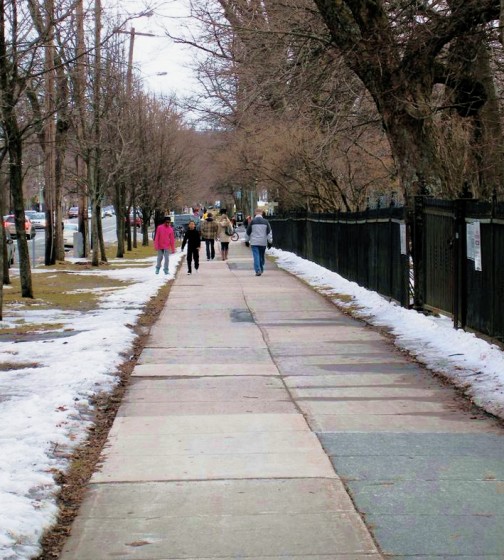On Friday I went to a workshop on creating walkable communities. At the workshop, urban planners, engineers and people working for healthy communities learned about tools and approaches to making walkable places. It was a great day. There are passionate people working across Nova Scotia to make it easier and safer to walk. Unfortunately, there’s a lot of hard work to do. Unfortunately, there’s also too little value placed on walking.
There are two main reasons why walking is unsafe or inconvenient. One reason is a lack of convenient places easily reached on foot. In too many communities, drug stores, banks and grocery stores are moving to the edge of town. Instead of a five to ten minute walk to key services on a traditional main street, many people now have a much longer walk to the edge of town. Newer stores and shopping malls also provide a poor environment for those not driving. This is the second reason walking is unsafe and inconvenient: poor infrastructure for people on foot. Picture your typical, modern grocery store: large parking lot, wide arterial road, narrow sidewalks (if any) and too much traffic. For most pedestrians it’s uncomfortable and a little unsafe; for people with vision problems, or who use a walker or wheelchair, it might be completely inaccessible. For decades, most new offices, services, stores and housing across Canada has been built in places where people can’t easily or safely walk. This is a huge problem.
There are many benefits of walking:
- Walking is good for people’s physical and mental health
- Walking produces zero emissions: no carbon dioxide; no particulates; no sulfides; no nitrous oxides
- Walking is free. People can get around without spending anything on transportation. Communities where basic services are only easily accessed using a car are deeply inequitable and deeply unfair
- Walking takes up very little space
There are many good reasons to prioritize walking. There are a few disappointing reasons why communities don’t prioritize walking: cars, money, apathy.
Cars travel quickly and take up a lot of road space, plus massive amounts of space for parking. If you’ve ever walked along a busy, high speed roadway, it’s obvious why too many cars, travelling too quickly, make walking a terrible experience. To make walking pleasant for more people, we need to take some space from cars and give it back to people. Unfortunately, most people travel by car. Some people only travel by car. There is usually resistance, sometimes fierce resistance, to any project that takes road space from cars.
Money is also important. There are only so many resources and many competing projects. Even if we quickly made walking a huge priority there’s so much work to do: road diets to shrink pavement widths; new curb cuts and curb bulbs; widened sidewalks; new crosswalks; new sidewalks; re-timed traffic signals. This only includes the road infrastructure that needs upgrading, not fixing the huge swaths of cities with few destinations and disconnected street patterns. Even with beautiful sidewalks and slow, attentive traffic, many neighbourhoods would still lack anywhere decent to walk to.
Finally there’s apathy. We seem willing to accept pedestrian injuries and deaths, low rates of exercise and low rates of walking, increased greenhouse gas emissions and poor mobility for the many households that don’t have a car. Why? Because cars are convenient – at least for those driving. We have to be clear – cars, in large numbers and especially when moving quickly, are terrible for pedestrians and people on bikes. The fact that so few people regularly walk is probably a huge reason why this point is often debated or downplayed.
We can’t shy away from this debate. For far too long, access to all that cities have to offer has been considered almost exclusively from a motorist’s perspective. Keep the traffic flowing and provide lots of parking has been the goal. The mobility and convenience has come at a tremendous cost – fewer people walking, fewer people able to walk and more pedestrians injured or killed. If we truly value walking, we have to target the biggest barrier to easy and safe walking: too many cars, moving too fast, and using too much space.
Walking is healthy, inexpensive and social. Walking takes less space and uses less resources than any other form of transportation. Walking is good and healthy, but for too many people and too many trips it’s unsafe, inconvenient or simply impossible. The fact that this seems normal and acceptable is an indication of how we have blindly sacrificed the health of our communities to what should be a useful tool – the automobile.
Valuing and fighting for nice, safe and convenient places to walk must become mainstream to make real progress. I bet almost everyone can think of someone they know whose life would be better if they had safer places to walk. Would you want your nieces or nephews to cross busy, high speed roads on their way to school? Would you want your elderly father or mother to spend their limited retirement income on cab rides because they can’t walk for groceries? Is it right that people with disabilities are physically unable to go many places because there are no sidewalks?
To fix the massive problems with our roads and our communities, we need to value walking. We need to value walking ahead of driving. It’s going to take more than a few dozen passionate planners and engineers at a workshop to make that happen.





